for electric DC motors
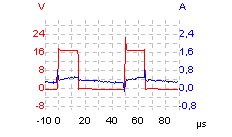
|
Some power PWM-drivers
for electric DC motors |
 |
Back to Stefan's Some technical projects page
Report by Stefan Spännare, January 2002, updated October 2006, May and June 2007
Note, print this web-page in landscape mode if the images don't fit into portrait A4.
These free power PWM-drivers for electric DC motors are based on
information found elsewhere on Internet. See the references below.
i. Warning
1. Introduction
2. Switching theory
3. Building instructions
4. The PWM circuit
Updated!
5. The +12 V power supply
6. Power PROFET PWM motor driver
7. Power MOSFET PWM motor driver
Updated!
8. MOSFET driver 1
9. MOSFET driver 2
Updated!
10. Electronic component data and prices
11. Some oscilloscope views of signals
12. Some images (photos) of the circuits
Updated!
13. References
The author makes no warranties that this document is free of errors.
Important note. A much more simple and probably superior PWM circuit is the
Perhaps the PWM circuit described here does not form the best PWM pulses.
Be very careful if connecting these circuits to larger lead accumulators. Very
PWM (Pulse Width Modulation) is an efficient way to vary the speed and power
The best switching conditions are when the switch frequency is much higher
The circuits below can quite easily be built on a standard laboration card. It is
Important note. A much more simple and probably superior PWM circuit is the
The author uses two TL 084 operational amplifiers in the Alternative modulator.
In the small circuit layout below is shown how the PWM pulse from this
PWM adjustment circuit for 4QD-TEC Alternative modulator:
The original old PWM circuit was found on Internet. Unfortunately the link seems to
Perhaps the PWM circuit described here does not form the best PWM pulses.
The following resistors and capacitors were used:
PWM circuit layout:
The small current parts (not the motor itself) could be powered from a +12 V
This power driver circuit is based on the PROFET transistor BTS 555 and
This power MOSFET motor driver is better than the PROFET driver because it is
This was the first MOSFET driver used by the author. But driver 2 is better.
This is the best MOSFET driver using a dedicated circuit (EL7212CN) as driver.
Here are presented some data (absolute maximum ratings) and approximate
These images are taken with a Pico Technology ADC-212/3 oscilloscope for PC.
1. PWM pulse over DC motor at 500 Hz and 30 % duty cycle. The motor dynamics (voltage
2. PWM pulse over DC motor at 20 kHz and 30 % duty cycle. Here the pulse frequency is
3. PWM pulse over car lamp at 500 Hz and 30 % duty cycle. At this low frequency the lamp
4. PWM pulse over car lamp at 20 kHz and 30 % duty cycle. At this high frequency the
1. An image of the PWM driver with PROFET (BTS 555) transistor and a large heatsink.
2. An image of the PWM driver with MOSFET (STP80NE06) transistor. This
3. An image of the (old) car lamp (12 V, 50 W) and the DC motor (15 V, about 100 W):
4. The new Alternative PWM modulator from 4QD-TEC.
5. The new improved power MOSFET driver (left) with the 40EPF04 power diode
Some useful images to download:
Some useful data sheets (mostly from ELFA) to download:
Some useful Internet links:
i. Warning
"Alternative modulator" found at 4QD's web-page:
4QD-TEC: Pulse Width Modulators
It can replace the complicated old circuit described below.
Experiments at 500 Hz show that there are fast oscillations at the end of
each PWM pulse. The author's oscilloscope is not fast enough to show if
there are such oscillations at a PWM pulse frequency of 20 kHz. Probably
this does not affect the function of the PWM driver very much.
high short circuit currents could be dangerous and destroy and burn your
circuits. It is highly recommended to first test the circuits with a current
limited power supply and a small motor.
1. Introduction
of electric DC motors. Here two drivers are described for 24 V (15 V to 30 V)
motors with a maximum current up to 80 A. These drivers can for example be used
to vary the speed of small electric vehicles. The first driver use a power PROFET
transistor switched at 500 Hz and the second use a power MOSFET transistor
switched at 20 kHz. The second method is preferred due to its higher frequency.
2. Switching theory
than the dynamics of the motor. The motor should "think" that it is powered
from a true DC voltage. Due to different references the frequency must be at
least 5 times higher than the rotation speed of the motor. I.e. if the motor rotates
at 6000 rpm (100 rps) the frequency must be higher than 5 · 100 Hz = 500 Hz.
A theoretically better explanation is that switching frequency must be much higher
than 1/Ta where Ta = L/R is the electric time constant of the motor. Here L is
the inductance and R the inner resistance of the motor. For a typical DC motor
(200 W, 24 V) L = 1 mH and R = 0.5 Ohm. This again means that the frequency
must be much higher than 1/Ta = R/L = 0.5 / 0.001 Hz = 500 Hz. Usually a
frequency around 20 kHz is used. This also avoids noise from the motor in
the audio range.
3. Building instructions
a good idea to have the power component (i.e. PROFET or MOSFET transistor)
on a separate card with the heatsink. See for example the images (photos) below.
The power component must be connected to the power supply or accumulator and
the motor with quite thick wires and cables. The author use 1.5 mm (1.77 mm²)
tin plated copper wires between the power components and the cable connectors.
This is probably enough for motors that use a current of up to 20 A on average.
The cables should also have an area of at least 2 mm². For higher current motors
the wires and cables must be thicker accordingly. As pointed out in the warning
it is very important to not short circuit, especially when connected to larger
accumulators. Always test with a current limited power supply and a small motor
first to see that everything works.
4. The PWM circuit
"Alternative modulator" found at 4QD's web-page:
4QD-TEC: Pulse Width Modulators
It can replace the complicated old circuit described below.
The capacitor C1 can have a value of 1 nF for a PWM frequency of about 20 kHz.
Use this modulator together with the circuits described in section 7 and 9.
modulator can be adjusted from 0 to 100 % with a 10 k potentiometer. The
3.9 k resistor is important to prevent the modulator from going stuck at
full PWM speed if the voltage to the + input of the operational amplifier
is too low. The 100 nF capacitor at the output of the potentiometer makes
the circuit less sensitive to disturbances and noise.
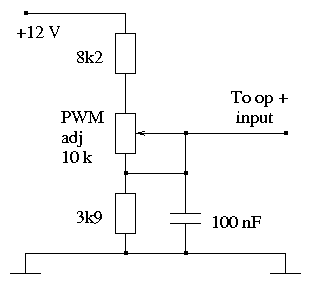
Old PWM circuit
have disappeared when this was written. The document can however be downloaded
here (see the references). The PWM duty cycle can be varied from 0 % to 100 %
with the 47 k potentiometer.
Experiments at 500 Hz show that there are fast oscillations at the end of
each PWM pulse. The author's oscilloscope is not fast enough to show if
there are such oscillations at a PWM pulse frequency of 20 kHz. Probably
this does not affect the function of the PWM driver very much.
f = 1 / (RC) (kHz)
R (kOhm)
C (nF)
0.5
22
100
20
2.2
22
5. The +12 V power supply
voltage regulator. Then the input voltage must be larger than +15 V. The
regulator survives a current of maximum 1 A with a heatsink. Circuit layout:
6. Power PROFET PWM motor driver
is working at a switch frequency of 500 Hz. The reason for this low switch
frequency is that the BTS 555 is a relatively slow component. This was the
authors fist experimental PWM setup. However the power MOSFET version
(below) is better. Note, the BTS 555 and the large diodes (DS75-08B and
DSI75-08B) require relatively large heatsinks for high current motors. Circuit
layout:
7. Power MOSFET PWM motor driver
working at a higher switch frequency of 20 kHz. This circuit also avoids the
voltage drop and power loss over the power diodes present in the PROFET driver.
The MOSFET transistor in this motor driver requires a special driver circuit
between the PWM circuit and the MOSFET itself. The reason for this is that
switching the gate voltage of the MOSFET transistor requires high transient
current (2 A) due to relatively high capacitive load. The MOSFET transistor
and the power diode require relatively large heatsinks for high current motors.
A good article about MOSFET drivers is found on Internet (see the references
below). Circuit layout:
8. MOSFET driver 1
Circuit layout:
9. MOSFET driver 2
Circuit layout:
10. Electronic component data and prices
prices for the most critical and expensive components in the circuit layouts
above. Imax and Pmax are given with appropriate heatsinks. Good heatsinks
are quite expensive.
Component
Umax (V)
Imax (A)
Pmax (W)
Ron (Ohm)
Price ($)
BTS 555
34
158
310
0.0029
10
STP80NE06
60
80
150
0.0085
5
DS75-08B / DSI75-08B
800
75
75
-
15
40EPF04
400
40
40
-
5
LT10A04
400
10
10
-
1
BD 139 / BD 140
60
1
8
-
1
BC 337
45
0.500
0.625
-
0.25
EL7212CN
16.5
2 (< 2 μs)
1
-
5
TL 084
36
-
0.5
-
1
11. Some oscilloscope views of signals
The current was measured by measuring the voltage over a 0.1 Ohm, 10 W thread winded
resistor, which probably also has some inductance. The resistor was connected in
series with the motor or lamp. The operating voltage was 18 V powered from a large
power supply which can handle a maximum average current of 15 A. The small transient
spikes that are seen at the positive flank of the voltage curves at 20 kHz probably
occur because the power supply is not fast enough to keep the voltage stable for a
short time. The DC motor (15 V, about 100 W) is running without load. The lamp is
of normal car lamp type (12 V, 50 W).
and current) have time to follow each individual pulse, which indicates that the pulse
frequency is to low.
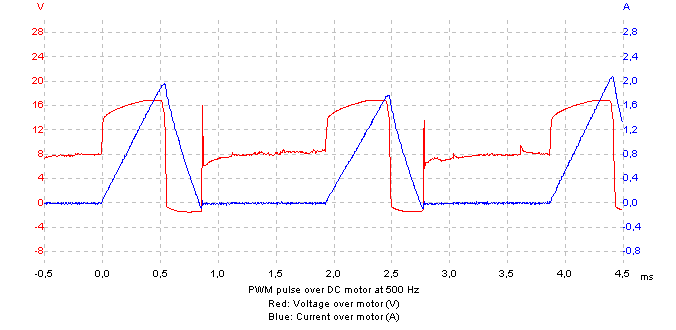
so high that the motor behaves almost as if powered from a true DC voltage. However some
transient current spikes occur at the flanks of the pulses.
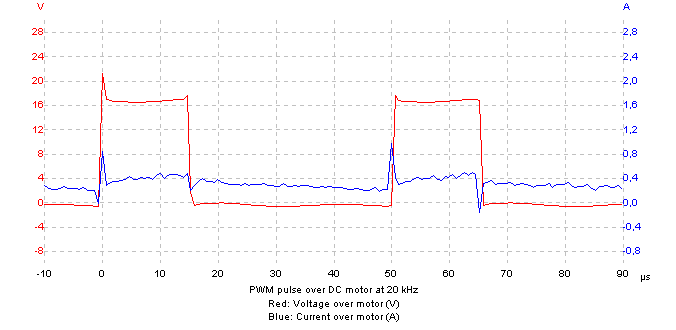
behaves almost exactly as a true resistor. I.e. the voltage and current follow each other.
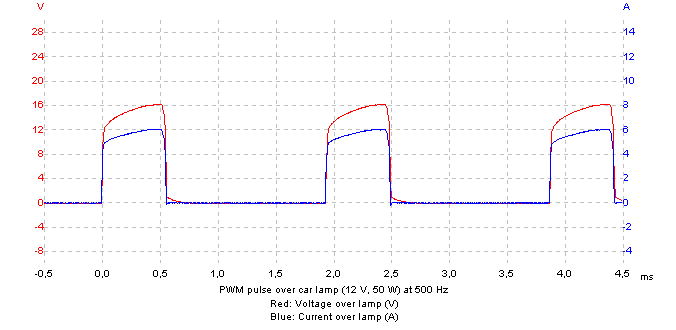
inductance in the lamp (and probably also the 0.1 Ohm resistor) gives large transient
current spikes at the flanks of the pulses.
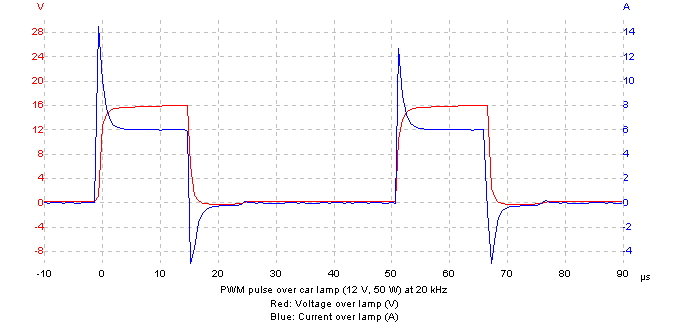
12. Some images (photos) of the circuits
The large diodes (DS75-08B and DSI75-08B) also have a large heatsink together.
driver use the "MOSFET driver 2" (i.e. the EL7212CN circuit). The MOSFET
must have a larger heatsink and a more powerful diode (for example 40EPF04)
with a heatsink for high current DC motors.
(right) and heatsinks.
13. References
by SIEMENS, December 1998
by SGS-Thomson Microelectronics, February 1998
by IXYS Semiconductor
by International IOR Rectifier, May 1997
by Philips Semiconductor, April 1999
by Philips Semiconductor, April 1999
by Philips Semiconductor, April 1999
by Elantec, 1994
by Texas Instruments, 1997
Author: Stefan Spännare
E-mail: stefan@NOspaennareSPAM.se
(Please remove NO and SPAM before sending)
Latest update: 2007-06-18